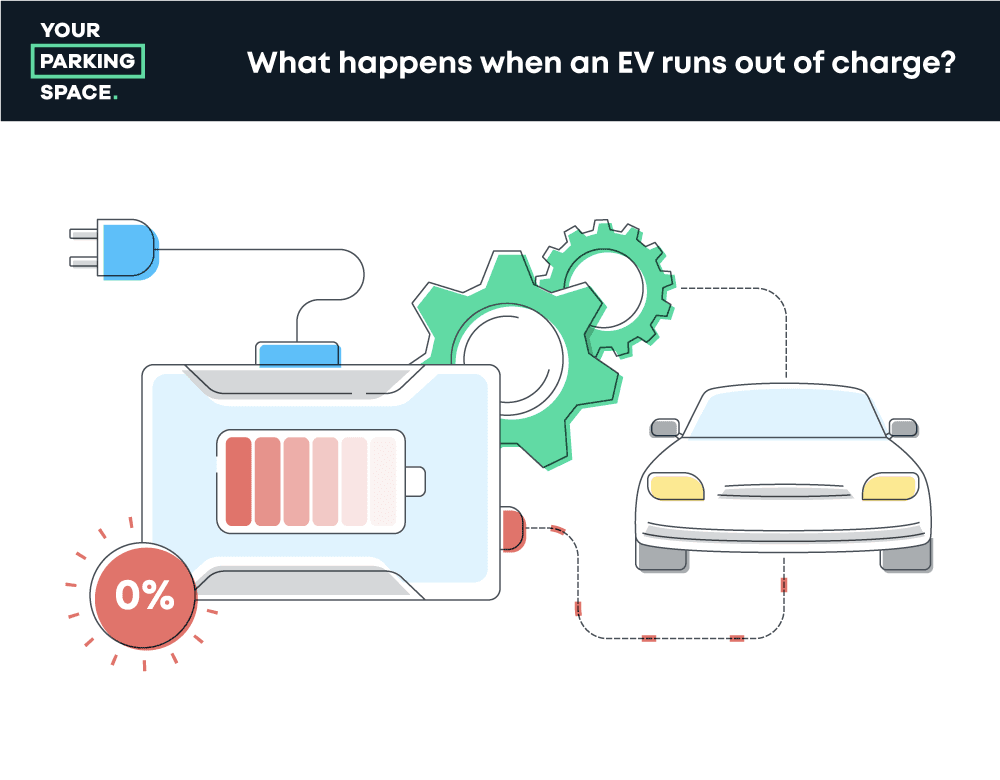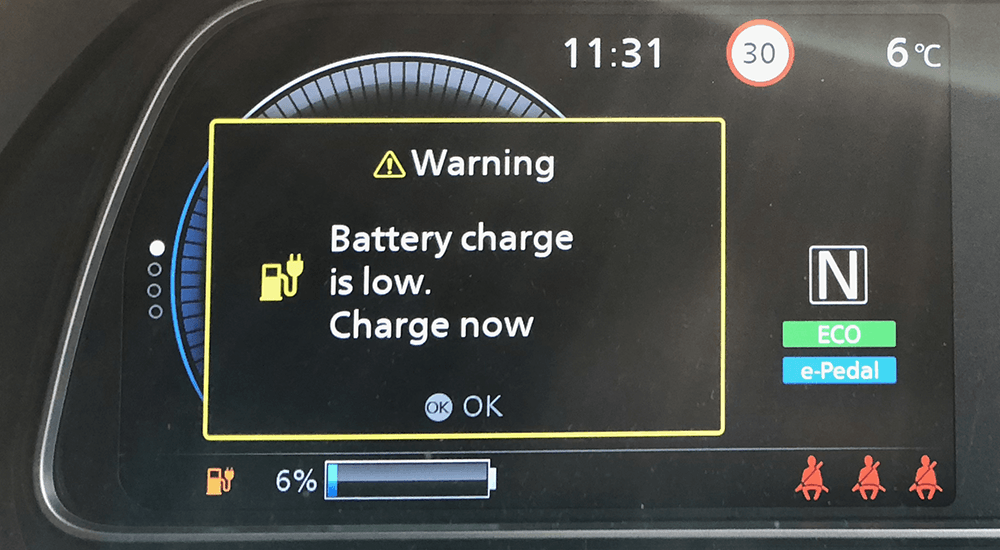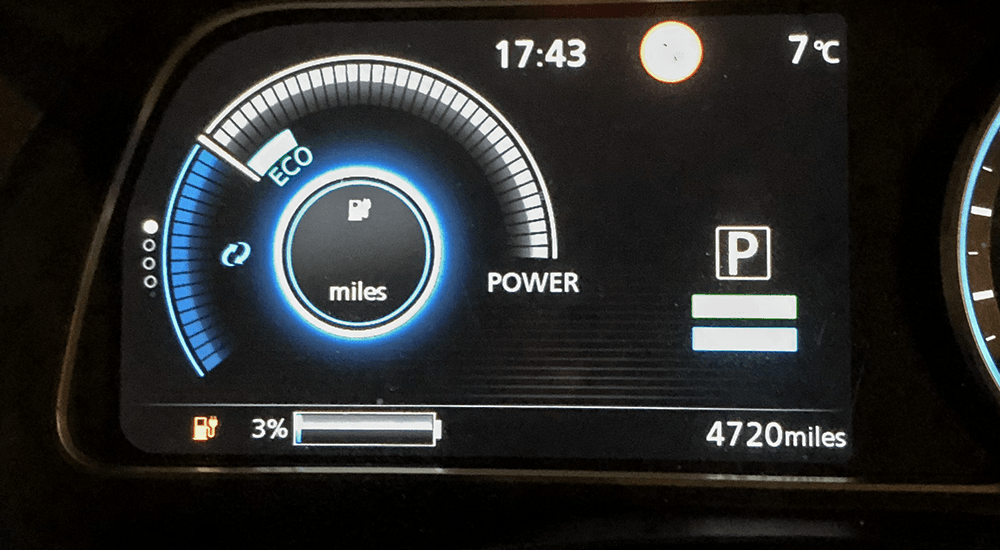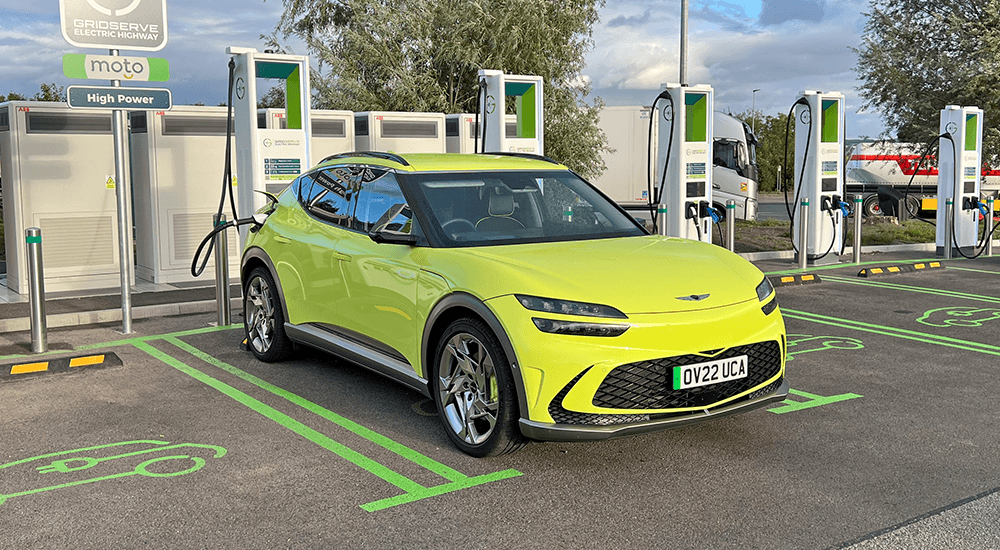Most drivers don't get worried about running out of fuel. There are petrol stations across the country, and even if you do stop somewhere, you can fill up a jerry can and carry fuel to your vehicle. It's not ideal, but something that drivers have grown up with.
Petrol cars can run out and simply be refuelled. Those driving a diesel vehicle are sincerely advised to not run out, as it requires more than just putting diesel back in the tank. But essentially, there is no "refuelling anxiety" with petrol and diesel models.

But what about electric cars? You can't really just carry a tank of electricity to your EV if it runs out of charge - or if you could, not only would the battery be huge but it would also take a long time to recharge. Granted, any three-pin plug socket can turn into an EV charge point in a scrape, but there aren't EV refuelling stations (or hubs) like petrol pumps across the country in large numbers yet. So what happens when an electric car does run out of charge?
Low battery in an EV

Many electric vehicle drivers will have pushed the car's range close to, or actually reaching, zero miles. Particularlythose earlyadopters with the first EVs which had relatively short ranges. Winter is a time that can shave miles off an EV's range quickly, potentially leaving drivers short.
Different drivers will have different approaches to their "fuel level". Some EVs have a very accurate range display, showing a precise number of miles left in the battery. Others will know how many miles their car will do per percent of charge, knowing that in certain conditions it will be longer and other situations shorter.
It makes for almost constant mental maths when the range is getting low as to whether you will get to your destination or not, and there tends to be a natural caution, rounding down with the maths, to try and make sure there is some buffer. But whatever the method of calculating how far they can travel, drivers will at some stage hit "zero".
Manufacturers will do slightly different things when the charge is very low. Most will put the orange fuel-low light on at around 20%, but some drop this to a lower figure, or sees the warning appear with 30 miles remaining.
From there, almost all EVs will suggest that you recharge soon, and most will offer to direct you to a nearby charger. As developments have been made, this has become more sophisticated, but many times it simply doesn't matter.
For example, if you're driving homeand are not too far away - 10-20 miles or so - you will likely know the route back, plus one or two back-ups. You know you will have enough range, and the route is unlikely to be in the sat-nav as you know where you're going. The car might not be clever enough to be familiar with the situation, but you're confident that the EV will make it home where you can charge easily.
Running out of charge

It's in those unfamiliar locations where that warning has far greater use. And here is when the mental maths starts kicking in. One of the closest times I have come to running out of charge was on a cold winter's nightin a Nissan Leaf. The car was showing a low charge warning, and the range dropped down to around five miles. And then… it went blank.
Thankfully, the Leaf shows a battery percentage as well as a driving range - not all EVs do - and there was still three percent remaining. I knew in those conditions that I could comfortable cover more than two miles per percent, meaning I could cover at least six miles and still have a tiny amount in reserve.
As such, despite being on a dual carriageway entering a town, the sat-nav showed that a couple of rapid chargers were only two miles away, and I was confident that I could make it to the charger without issue - which I did. So it's worth remembering to rely on your instincts and maths.
EV drivers quickly recalibrate what is an acceptable range remaining figure. For most driving a petrol or diesel car, when the fuel reserve light comes on, it's time to urgently find a petrol station. For EV drivers, their car may show just 30 miles remaining, yet they are comfortable with at least another 20 miles' driving before needing to recharge.
Again, things will vary slightly from manufacturer to manufacturer, but electric cars will, when they get to zero charge remaining, at some point go into "turtle mode". This effectively cuts the power down to almost nothing, and is intended to be a safey feature.
If you run out of charge in the outside lane of a motorway, it's as dangerous as doing so in a petrol or diesel car. You need to get across to somewhere as safely as possible, and it is hoped most drivers would not push the range that far when on a motorway. But depending on where you are, that extra tiny bit of travel distance can be the difference between stopping somewhere dangerous and somewhere safe.
Turtle mode really does inhibit the car's performance, and it will literally bring the car down to walking pace. The setting will kick in earlier on some models than others, depending on the manufacturer's settings, but it's always a time to get to the side of the road ASAP.
Getting back on the road

Having run out of charge in a first-generation Kia Soul EV, I can attest that turtle mode lasts about 100 meters - it really is a last line of defence and not something to push your luck with. Others can go a little further, the Leaf will cover approaching a mile, but most will cut the power much sooner than that.
Before that, you will have around 5-10 miles of range despite it showing zero on both the driving range and the battery percentage, but once turtle mode kicks in, you'd better be able to see the charge point if you're going to get there.
By this stage, the car has been warning you repeatedly, telling you not to push your luck, offering help to get to a charge point, and then warning that there are no charge points in range. When the car finally completely runs out of charge, you half expect a message popping up saying "well I told you so!".
Instead, what happens is the car just dies. It's like running out of power with a computer or a mobile phone. It gives up, and stops completely. There are still interior lights able to be turned on, hazard lights can be put on, and the screens still show their displays, but that's because an EV still has a conventional car battery as well. It doesn't power the vehicle, but is used for auxiliary systems.
When there's no power, the car will still be able to be pushed as long as you put the car into neutral. Use the foot brake to slow down/stop, and there is no power steering, but the wheels can still be steered - in essence, the EV is just like a petrol or diesel model.
It's likely to be heavier than a comparable internal combustion car to push, but it can be pushed out of the way if needs be. However, most will call a recovery service. The likes of the AA and the RAC will be able to tow you to a charge point or get you home/somewhere familiar, where you can recharge the car.
The RAC has some patrols that have a small generator in the back of the van which can recharge the car a little - enough to give you a few miles' range if there are faster chargers in the area. But if you're in the middle of nowhere, they will tow you where you need to go.
From there, you just plug the car in and let it charge. As it's completely empty, the battery will take the longest possible time to share no matter the charge point, but it will charge fine still. There's no need to reset anything, or replace/repair systems. Again, think of the car like a phone or computer - it just needs some power to sort itself out.
Those running out of charge will not beable to claim that it's not because of a lack of warning. The car will positively irritate you into submission most times before running out of juice, and you will either be no where near a charge point, or a sucker for being pestered by a vehicle, before finally conking out.






